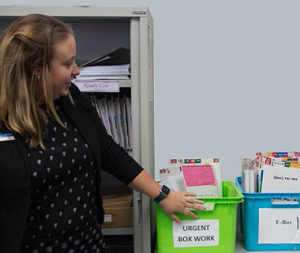Handwriting school

Self-confessed ‘geek’ Sarah Armiger-Wills, Court Registry Officer at Whangarei High Court & District Court has always had an interest in IT. What she’s also got in spades is enthusiasm – and a real passion for her work, which has seen her develop and roll out, with the support of Judge Murray Hunt, a tool called E-Box.
E-Box is an electronic system for ‘box work’ or ‘chambers work’, used in the Family Court.
Registry staff are able to create a ‘memorandum to the judge’ that gives information on the status of a file and asks the judge for directions to progress the file. This memo is saved on a network drive that both the registry and judiciary have access to. The judge is able to open the memo, type in their directions and re-save it. The memo can then be released to counsel or parties as required.
The system has been implemented in a way that mirrors the case officers’ physical approach to filing. If a physical file is placed in a ‘red’ bin in the filing area, it can also be found in an E-Box folder labelled ‘red’ on
the shared network drive.
It’s a system that’s unique to the Family Court, due to the level of interaction between judges and staff through memos on files, which doesn’t happen to the same degree in other jurisdictions.
And it has made a significant difference in terms of timeliness.
‘In late 2014, it was taking around 2 to 3 weeks turnaround, from when a judge had finished giving a direction, to actually getting it out to counsel and other parties,’ says Sarah.
‘That’s two weeks of someone’s life, essentially in limbo, where they’re waiting for a decision from a judge such as in relation to a custody case, or a care and contact arrangement.
‘Now it takes around 4 to 5 days. Cases are progressing faster, which means quicker disposal of files.’
The previous process was time-consuming, with judges writing their decisions directly onto a physical copy of a memo, which case officers would then read and type up.
However, deciphering a judge’s handwriting could sometimes be difficult, and case officers would often have to go back to the judge to clarify a decision. If the judge wasn’t available, this meant waiting.
‘As someone who previously worked in a pharmacy, I often used to joke that doctors and judges went to the same handwriting school,’ laughs Sarah.
So she came up with a solution, E-Box, by ‘thinking about how we can make a difference within the system we already have’.
Judge Hunt was a trailblazer for E-Box, immediately recognising the potential of Sarah’s ‘number 8 wire’ solution and approving its implementation at Whangarei District Court, which took a mere few days. It has since been rolled out nationally.
He’s quick to demonstrate how it works, taking things a step further by using a dictation programme to convert his spoken words to print, through his computer.
‘Saving time and eliminating the potential for mistakes are two very worthy objectives,’ says Judge Hunt. ‘Further, the availability of an easy to use dictation programme, in combination with E-Box, allows the work to be dealt with more quickly by a judge.
‘Time is precious and timeliness is important.’
This story is from our 'Justice: Our People, Our Communities' booklet.
This page was last updated: